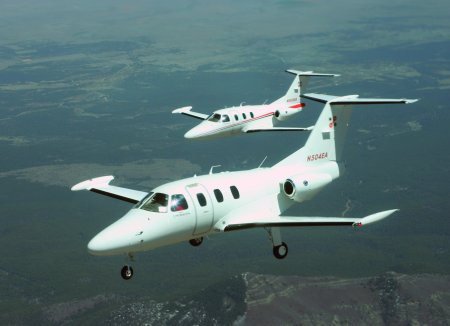Very-light-jet test fleet passes 500h milestone as manufacturer builds momentum on road to certification
The Eclipse 500 very light jet (VLJ) flight-test programme is gathering momentum and may even be close to the original target of achieving 750h by the end of October, despite the recent wheels-up landing of one of the “beta” test aircraft.

Manufacturer Eclipse Aviation’s aggressive drive to regain lost time comes as the test fleet passes the 500h flight-test milestone on the road to a planned US Federal Aviation Administration certification in March 2006. Although Eclipse originally wanted to pass this mark in August, the remaining test airframes are now accumulating hours at a rapid rate, says the New Mexico-based company.
The fourth conforming test aircraft, which is designed to build routine flight cycles and augment the initial three certification aircraft, is expected to rejoin the test fleet by the end of October after undergoing repairs following its gear-up landing on 4 September at Albuquerque International airport.
The aircraft, N505EA, is the first of two planned beta function and reliability test airframes. The second beta airframe, N506EA, is expected to appear at the US National Business Aviation Association convention in Orlando, Florida in November. Test accomplishments include top speeds of up to 285kt (530km/h) and an altitude of 41,000ft (12,500m), and the completion of lightweight foreign object damage (FOD) testing at various throttle settings up to take-off thrust, and at a variety of speeds ranging from standstill to 70kt.
Other tests included water ingestion work, which climaxed with an aircraft taxiing through a 40mm (1.5in) trough of water at speeds up to 100kt to simulate heavy rain conditions. Other highlights include 20 landings in one day on one aircraft to test tyre wear, achieving more than 100 test points on a single aircraft in one day, and endurance testing with single flight durations of more than 3h.
The Eclipse 500 has also been cleared by the FAA for an initial 10,000h structural life limit following the completion of static tests at the South West Research Institute in San Antonio, Texas. “The goal is 20,000h, but to have got this clearance without the fatigue test demo is virtually unprecedented,” says the company, which expects to extend the life limit on the completion of the second tests which are due to start within days.
The company adds that a gear warning system, which will provide audible and visual warning in the event of potential gear-up landing, is due to be installed as planned as part of a pre-certification software load.
GUY NORRIS/LOS ANGELES
Source: Flight International



















